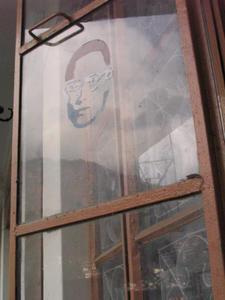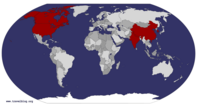Advertisement
Published: February 2nd 2006

 tenzin image
tenzin image
The stylized image of Tenzin Delek Rinpoche is a useful tool in spreading his story. One Tibetan in McLeod Ganj, Dharamsala, took it upon himself to pass the face around. This is his own window, incidentally.
He also co-produced a documentary, Sentenced to Die. More info about the documentary can be found at:
www.sentenced-to-die.comI wrote the following article in order to spread awareness on what is still occuring, not only to Tibetans, but to Uighurs, ethnic minorities, and even citizens in the People's Republic of China today.
While I am not actually there now, travelling is about being there and about how you are affected by, how you affect, people from the places in which you travel. So, these people affected me a great deal. And I can try to help affect their shameful circumstances.
Besides, I did kind of travel... to Toronto...just over an hour away... that's travelling.
Tenzin Delek Rinpoche, an incarnate lama from Eastern Tibet, will pass yet another year in his Chinese prison cell, location unconfirmed.
He’ll spend a solitary Tibetan New Year’s, or perhaps he’ll have the company of his captors, because he had the audacity to work to improve Tibetans living standards, to voice his concerns to the People’s Republic of China (PRC) government.
Just over three years ago, December 2, 2002, Trulku Tenzin Delek Rinpoche was sentenced to death, accused of conspiring against the state (the PRC) and of “splittist” (anti-government) actions, in the form of alleged bombings
in the Chinese city of Chengdu, Sichuan province.
He and his hypothetical co-conspirator were imprisoned, the latter, Lobsang Dondrup, hastily executed and the former sentenced to death, both without a just and open trial. Oh, there was a trial, so the People’s Republic of China authorities claim. It was a hoax. The lawyers present to “defend” the accused were of the PRC’s choice (the family’s own independent counsel being rejected). No evidence was procured to show the defendants’ guilt. It was closed, rushed, and false. And a man died because of it. And another one withers in prison because of it. And they are not alone. (1)
This was after almost eight months of detention and questioning by the PRC, using highly questionable methods most certainly involving torture. In the PRC version of a court trial, Lobsang Dondrup stated "Neither Tulku Tenzin Delek nor I am involved in any way with the bomb explosions. The trial was unfair." (2)
Tenzin Delek Rinpoche was sentenced to die. International outcry and pressure forced the PRC authorities to commute his sentence to life-imprisonment, though they cite good behaviour as the reason for this reprieve
Why was this man sentenced?

 tenzin vigil
tenzin vigil
Toronto, Jan 26, 2006. As in major places around the world, Tibetans and supporters gathered to voice their knowledge of the real situation in Chinese prisons.
The non-violent candlelight vigil took place opposite the Chinese consulate, a good-sized, mixed crowd turning out to support it.Was he a big, bad, terrorist splittist?
In McLeod Ganj, Dharamsala, North India, December 2005, I met with his nephew, “Gyaltsen”. Gyaltsen was raised by the Rinpoche. From an early age, he left his family to live with Tenzin Delek, and from that early age was influenced by the great lama’s pacifist approach. Consequently, Gyaltsen emanates the way of life his uncle taught him: he is Peace walking; he considers others first; he is a mediator, a reconciler.
Gyaltsen told me about his uncle one day. He talked of how his uncle had made changes in their remote community: building schools and clinics, and encouraging the study of Buddhism by his teachings as well as his actions. Human Rights Watch (HRW) reports Tenzin Delek also built a permanent structure in the place of tents, establishing other monasteries in the region, also building an orphanage, and old-folks’ homes. (3)
He was very vocal in his criticisms of the PRC party and their fouling of the environment, scouring the forests of trees and the earth of minerals. Yet, he was able to achieve substantial improvements in his region through his diplomatic approach. In his own words “I have always
carried out my work within one country, meaning the People’s Republic of China. The work I have undertaken has been to unite people, to develop their welfare, to protect the environment, to promote economic development for the people, and to promote education… Everything I did, they considered a crime.” (4)
HRW surmises that it was this activism over a period of twenty-five years, and Tenzin Delek’s increasing popularity—he apparently had several hundred followers—which led the PRC to chase him down, halt him, imprison him. A HRW report cites that PRC authorities began their crackdown in the nineties, slowly at first, by restricting his movements and speech and by constant surveillance and threat of arrest which twice had Tenzin Delek Rinpoche running for the hills in escape.
Gyaltsen recalled how one morning in 1997 his uncle simply wasn’t around and no one knew whether he had been captured by the PRC authorities or not. Upon his later return it came out that Tenzin Delek had known the authorities were coming and had escaped during the night, heading far north to lay low for a while. (5)
One might question why the PRC would want to curtail someone who
was doing their work for them. After all, he took upon himself the task of providing basic amenities that the so-called government should have been supplying. Yet, rather than gratitude for establishing community services, in 2000 the government took control of his Geshe Lungpa school for poor children and orphans. Within three years the school had lost funding, fallen into disrepair, and without leadership closed down. As the detailed HRW report states, the Rinpoche was using money he had earned through his duties performing Buddhist rituals to fund the school and very likely to fund another school, two old folks’ homes, and a clinic. (6)
The reason for the closure and down-sizing of monasteries and nunneries is more evident: the PRC has been grappling with Tibetans’ Buddhist devotion since invading and “liberating” Tibet in 1949. Throughout the decades, various horrors of unimaginable degrees of malevolence have occurred with the aim of eradicating Tibetan culture, religious devotion, and particularly devotion to their holy leader, the Dalai Lama. (7) The recent resurgence of this ongoing identity-erasure campaign is the so-called “Patriotic Education Campaign” of 1996, really just an old idea dusted off. The PRC has used the practice of reform-through-labour since
invading, exhausting detainees through physical labour, then indoctrinating them with PRC ideologies.
The current Patriotic Education practice sends Chinese “work teams” into nunneries and monasteries to educate nuns and monks on the PRC ways and beliefs. The weeks-long sessions end by demanding the tutees sign a declaration vowing their allegiance to the ‘motherland” (the PRC), denying Tibet’s former or future independence, and denouncing the Dalai Lama. This is something most Tibetans will not do, and they suffer the consequences. According to the Canada Tibet Committee, over half of Tibetan political prisoners are monks and nuns (8), imprisoned for such offences as possessing and displaying the Tibetan flag (illegal in Chinese controlled Tibet) or photos or literature of the Dalai Lama (also illegal), printing or shouting freedom slogans, and declaring allegiance to the Dalai Lama. A recent indoctrination campaign in Drepung monastery, Lhasa, culminated in the expulsion and arrest of at least five monks, the known death of at least one monk, and the severe limitation of exit of the entire monastic community. (9)
This is the People’s Republic of China in 2006.
I left Gyaltsen with self-instigated promises to help spread the word. That is the problem:
it is 2006, the media reports selectively, and we are nonetheless inundated with atrocities occurring around the world. Where to start, who to listen to, how to help? While the ways of the PRC authorities against minorities like Uighurs, Tibetans (minorities in their own homeland), and various Chinese ethnic groups seem insurmountable, pressure from the international community has been successful in many cases. (10)
January 26, the anniversary of Lobsang Dondrup’s unmerited execution serves as a day of reminder and a day of impetus. Around the world, Tibetans and supporters hold vigils of remembrance and solidarity, striving to disseminate information on the real situation of Tibet today and to help free a man jailed despite his non-violent approach to improving the lives of his people.
"I am completely innocent...I have always said we should not raise even our hand at others. It is sinful.... I have neither distributed letters or pamphlets nor planted bombs secretly. I have never even thought of such things and I have no intention to hurt others." (11)
For a very informative example of Tenzin Delek Rinpoche’s motivation and thinking, see
http://hrw.org/reports/2004/china0204/16.htm#_Toc63073895
Endnotes: (1)From an

 patriotic education march
patriotic education march
This is actually from Dharamsala, India, just after news came out of the situation in Drepung monastery.interview with Gyaltsen (name changed for safety reasons), the nephew of
Tenzin Delek Rinpoche, December 2005, in exile in McLeod Ganj, North India; and
http://hrw.org/english/docs/2004/02/06/china7278.htm
(2) http://www.tibetanyouthcongress.org/tulkustatement.htm
(3) http://hrw.org/reports/2004/china0204/4.htm#_Toc63073868
(4) http://hrw.org/english/docs/2004/02/06/china7278.htm
(5) Interview with “Gyaltsen”, December 2005.
(6) http://hrw.org/reports/2004/china0204/9.htm#_Toc63073880
(7) There is an ample supply of literature to document the destruction and torture in Tibet
during the last 56 years. Websites like http://www.savetibet.org/news/links.php
http://www.guchusum.org/ http://www.drapchi14.org/drapchi14/ and
http://www.tchrd.org/ are good places to start. For non-Tibet affiliated documentation,
www.amnesty.org www.hrw.org and www.laogai.org
(8) See http://www.ctctoronto.ca/briefs/index.jsp?physName=religiouspersecution
(9) See http://www.tchrd.org/press/2005/pr20051129.html for more information.
(10) Examples of international pressure resulting in success:
http://www.freetibet.org/campaigns/tdr/campaign_successes.html
http://www.studentsforafreetibet.org/article.php?list=type&type=75
http://www.amnesty.ca/about/good_news_stories/
(11) http://actionnetwork.org/campaign/SaveTenzin/explanation
Further Interest: For well-documented information on Tenzin Delek’s case: http://hrw.org/reports/2004/china0204/
http://web.amnesty.org/library/index/engasa170032004
http://www.cecc.gov/pages/news/lobsang.php
http://web.amnesty.org/library/Index/ENGASA170292003?open&of=ENG-CHN
http://www.freetibet.org/campaigns/tdr/index.html
For information on how to take action to help TDR:
http://actionnetwork.org/campaign/SaveTenzin/
http://www.savetibet.org/campaigns/tdr/index.php
http://www.tchrd.org/urgent_action/action.php?trulku_tenzin_delek
Reports on another example of repression in Tibet:
http://www.tchrd.org/publications/topical_reports/destruction_of_serthar-2002/
http://www.tchrd.org/downloads/
http://www.savetibet.org/campaigns/politicalprisoners/index.php
http://www.guchusum.org/act/index.html
For an amusing PRC take on the case:
http://news.xinhuanet.com/english/2005-01/26/content_2510555.htm
For general information on Tibet history and events in the

 tenzin image
tenzin image
www.savetenzin.orglast half-century:
http://www.savetibet.org/tibet/history/index.php
Advertisement
Tot: 0.103s; Tpl: 0.018s; cc: 12; qc: 28; dbt: 0.0298s; 1; m:domysql w:travelblog (10.17.0.13); sld: 1;
; mem: 1.1mb









